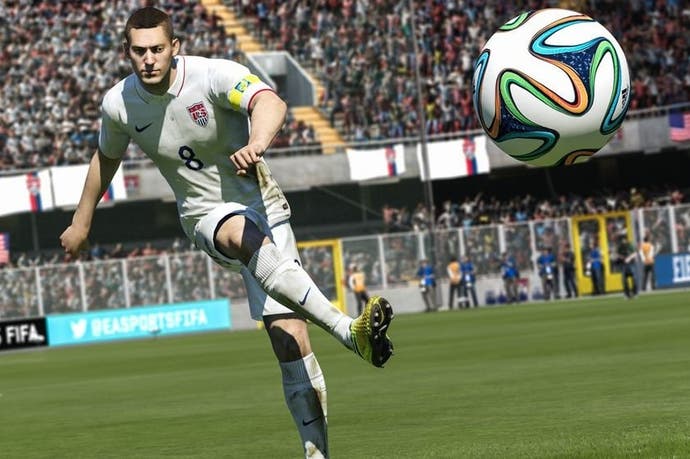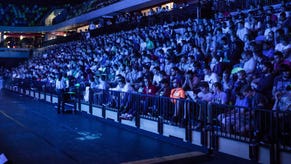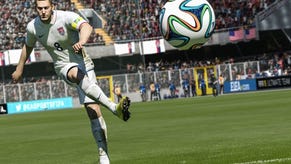Face-Off: FIFA 15
Moves like Agger.
UPDATE 20/10/14 3:35pm: In this article, we note that motion blur is a key omission on the Xbox One version of FIFA 15. We can confirm that the patch released today fixes this.
Original Story: If last year's FIFA laid a foundation for the series on PS4 and Xbox One - debuting an Ignite engine that brought 1080p visuals and 3D crowds - then FIFA 15 is a sure-footed next step. Developer EA Canada uses its extra year to enhance the game's lighting and physics in particular, making the generational jump from PS3 and 360 that much more profound. But with the series pushing Sony and Microsoft's new consoles harder, is parity still being upheld between the two? And indeed, is everything intact for the PC's first use of Ignite?
At first, it all looks like change for the prettier. New to the series is a physically-based approach to lighting, meaning player skin shaders and kit fabrics react more naturally to each stadia's spotlights. The look of each stadium benefits here. The Nou Camp pitch now receives a layer of grass shader mapping too - seen subtly popping in during instant replay camera swoops. The net result is a richer, more reactive pitch surface, where lighting brings an eye-catching, specular property to each grass tuft.
FIFA 15's animation system gets a much-needed boost too. New facial expressions open the gates for flashing grins from prevailing strikers, angry toss-ups between players, and even nervous, corner-mouth twitches from assistant referees. In-game movements are covered as well; the excessive sway on kits is now reduced from last year, and players are seen breathing visibly as they make darting sprints. It's still very much in the uncanny valley up-close, but the traditionally gormless appearance of the players is at least minimised.
Added to that, physics properties are added across the pitch on PS4, Xbox One and PC. Goalposts tremble on shot ricochets, corner flags flop, and player hair sways with each stride. These are subtle changes, but welcome nonetheless. More noticeably, pitch degradation makes an introduction this year. It's purely an aesthetic switch-up, but lets each footstep and sliding tackle gradually scar the field, marking the progress of the game up until the 90th minute.
Much of this feature-set is shared across all platforms. The PS4 and Xbox One releases are principally like-for-like in every test, though looking closer, we notice one major difference. On Xbox One, per-object and full-screen motion are entirely missing, while the final PC and PS4 final builds retain it. This adds a filmic, fluid quality to motion that replicates the look of a live broadcast - easy to miss during regular gameplay but the difference is hugely evident during replays and cut-scenes.
In a curious twist, the Xbox One's FIFA 15 demo features the effect - and at no apparent performance penalty. What's just as strange is that this Liverpool versus Manchester City demo actually loads on first booting the Xbox One retail disc with the effect intact, but once the match is played out, motion blur is switched off for the main game (a bug perhaps?). In all, this is the only major technical division between the three versions - with the PC release retaining the effect.
Alongside this, a demanding bokeh depth-of-field effect is added to all versions, where previously we had a simpler Gaussian blur across intruding foreground objects. And while both consoles run at bona-fide 1080p, aliasing creeps in as a result of the effect. From our pixel counts, it appears the filter uses a lowered 960x640 buffer, causing objects walking in front to look rougher at certain angles - typically in scenarios with a close-up of a player in front of the stands. It's a trick in need of some refinement, but on balance it adds to the look of FIFA 15's cut-scene segments.
Meanwhile, the Ignite engine's PC debut is a successful one, insofar as it matches the Xbox One and PS4 versions point-for-point. However, those on top-end rigs looking for any extra tricks will leave disappointed. Options include two modes for graphics quality, with its 'high' mode matching the home console editions - plus toggles for up to 4x MSAA, and frame-rate caps at 30 and 60fps. In this sense, it has one advantage, with Sony and Microsoft's hardware delivering 1920x1080 resolution with just 2x MSAA to suit. But right down to the blurry texture map on snowed-over pitches, the PC does little to really branch out in a bold graphical direction.
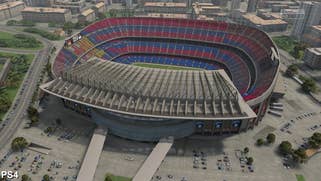
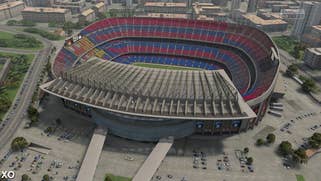
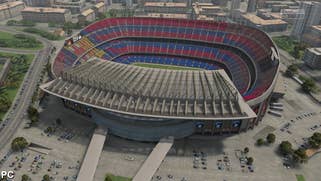

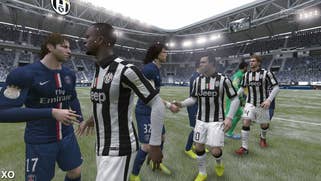




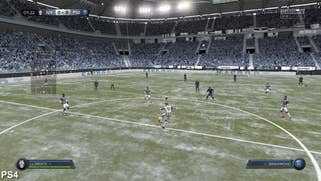
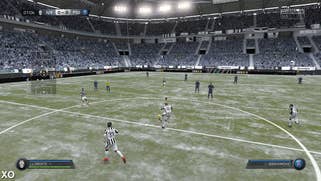
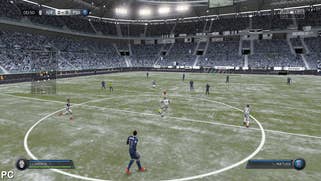
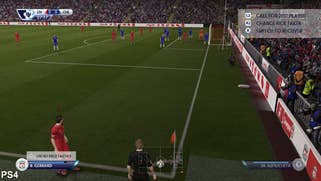
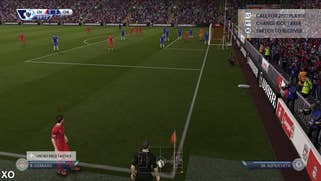
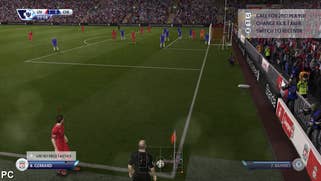





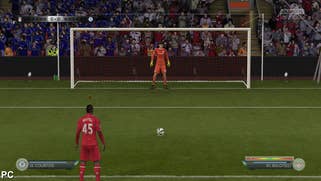
The PC version's performance levels also match the PS4 and Xbox One releases, for better and worse. All three run at a matching, perfectly v-synced 60fps when using the popular, default 'top-down' camera view. However, FIFA 15 carries on the series' tradition of automatically capping to 30fps for the match preambles, replays, set-pieces and anything using the Pro camera mode.
This goes for PC too, alas. It's a shame that our setup, equipped with a more than capable i7-3770K processor, 16GB of RAM and a GTX 780 Ti, also caps to a 30fps readout during these sections. This is despite a 60fps limit selected in the options menu, where in games prior to the Ignite engine's introduction, it would permanently stick to that 60Hz rate regardless. Once upon a time, this gave PC a distinct performance lead over consoles in overall consistency - but no more.
It's also baffling when testing the actual frame-rates theoretically possible on PC. By running with an uncapped frame-rate, our test rig carries the game at around the 140fps mark, rarely dipping below 100fps. It's more than capable, in other words, but an option isn't available to permanently cap at 60fps, or any other value that might match your monitor's refresh.
Meanwhile, both the PS4 and Xbox One handle in-game playback perfectly; if it's in default view, the 60fps line is held to a tee. However, the Xbox One does occasionally suffer from drops to 25fps during match build-ups locked at half rate, noticed when panning past each team's line-up. It's unusual - and doesn't affect gameplay - but by comparison the PS4 never misses a beat here, whether it's running at a 30 or 60fps cap. [Update 27/9/14 5:58pm: For cut-scenes, both PS4 and Xbox One use a cross-fade effect for switching between camera shots. Readers rightly point out a dip during this transition - in this case, a discrepancy where we get a 22fps read on the PS4 side. It's a minor quirk of this transition effect which appears on both platforms in our experience - a shot occasionally holding for a few extra frames before starting to overlay the next. Thankfully, it's not an issue for the actual rendering of gameplay.]
FIFA 15: the Digital Foundry verdict
On balance, this year's FIFA makes a satisfying march forward on technical grounds, for both PS4 and Xbox One alike. From the new bokeh depth-of-field effect, to the new player animations and revamped lighting model, both versions offer practically like-for-like returns on EA's investment into its Ignite engine. A slew of other subtle extras make it one of the series' more progressive entries overall, and crucially, both perfectly hold at the 60fps mark where it counts.
But with all the additions being made, there are already signs that the thin end of the wedge is dividing the PS4 and Xbox One versions. The omission of motion blur from the Microsoft release, for example, plus a few occasional frame-rate dips during cut-scenes, suggests the weight of these engine advances is starting to take its toll. It's rare to see a break in parity between the modern entries in this series, but FIFA 15 marks the first time a more obvious distinction can be made.
It's not a deal-breaker of course. To the Xbox One version's credit, it receives 14 exclusive Legends players for FIFA's Ultimate Team mode, joining an existing roster of 41 Microsoft-exclusive players from last year. From a content perspective this is a boon, but in the face of the PS4 version's technical advantage perhaps a trivial one - give or take your commitment to this mode. The PC version also makes a sturdy first use of the Ignite engine; a frills-free offering outside of its 4x MSAA, but - for better or worse - a match for the PS4 version in visuals and frame-rate locks.
